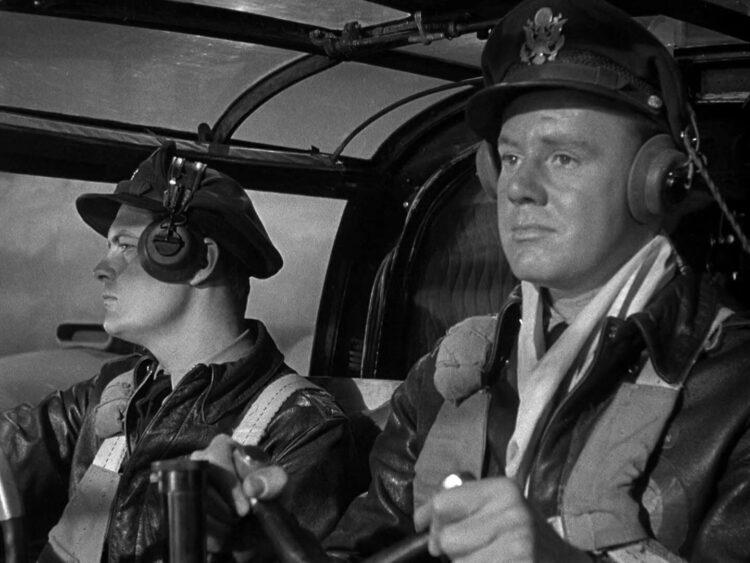Metro- Goldwyn-Mayer released a morale-boosting film during World War II that has since been recognized as a Hollywood classic. It was recently broadcast by the Turner Classic Movies channel.
Thirty Seconds Over Tokyo, directed by Melvyn LeRoy, with a screenplay by Dalton Trumbo, is based on a book written by Ted Lawson, a pilot who participated in the United States’ first retaliatory air strike against Japan on April 18, 1942. The raid, planned and led by Lieutenant Colonel James Doolittle, deployed 16 B-25 bombers and targeted Tokyo and four other Japanese cities, and was considered a success.
The 138-minute film, released on November 14, 1944, nearly three years after Japan attacked the U.S. naval base at Pearl Harbor, incorporates actual footage of the strike. Produced at a cost of $2.9 million, it garnered $6.2 million at the box office.
James Agee, the movie critic of Time, described it as a “big studio, big scale film, free of artistic pretentious.”

Doolittle, an aviator and aeronautical engineer, was given several months to prepare an attack plan and train its volunteers, none of whom were privy to the details of the top-secret operation until it was launched. What they knew was that it would be a dangerous mission requiring rigorous training in Florida and California, and that they would be gone for three months.
Spencer Tracy plays Doolittle, a serious and somewhat aloof commander totally dedicated to the task at hand. Van Johnson portrays Lawson and Phyllis Thaxter is his pregnant wife, Ellen. Robert Mitchum has a minor role as one of the airmen.
In terms of its ambience, the picture swings like a pendulum between jocularity and uncertainty, and it is never less than patriotic.
Mercifully, it is not mindlessly anti-Japanese, as were some of the American movies from this period. As one of the pilots says after receiving a briefing, “I don’t hate the Japs yet, but I don’t like them.”
The volunteers, all-American boys from every walk of life, are animated by a spirit of camaraderie. They chat, tell jokes, bond, and attend dances during which they profess their love for their wives or girlfriends.
The crew of a B-25 bomber consists of a pilot, a co-pilot, a navigator, a bombardier and a gunner/mechanic. The essential aspect of their intensive training is to learn how to take off on a runway no longer than 500 feet, the equivalent of an aircraft carrier. If a plane malfunctions, it will be pushed into the water.
On the eve of the mission, the men are woken up in the middle of the night. “We’re going straight to Japan,” says Doolittle, explaining its finer points. They are to bomb military targets and nothing else, but as Doolittle notes, civilians are bound to be killed because they work at a such facilities.
The aircraft carrier USS Hornet delivers them to the starting point 400 miles off the coast of Japan, or beyond the range of Japanese fighter jets.

The raid unfolds about seventy minutes into the picture. It is stirringly filmed by Robert Surtees and Harold Rosson, who won the Academy Award for cinematography.
Doolittle leads the pack. They fly low over the Pacific Ocean, heading toward the Japanese mainland. The camera pans on Lawson and his crew aboard their plane, The Ruptured Duck. The tension is palpable as factories below explode in flames and black smoke.
The Japanese are never seen. They are the menacing enemy from afar.
Upon the completion of their mission, they are to fly to landing zones in China controlled by pro-U.S. Nationalist forces. But being low on fuel, most of the pilots are compelled to ditch their planes in the surf before reaching their destinations. Lawson, seriously injured, is rescued by friendly Chinese. Still other crews are captured by Japanese soldiers.
Their Chinese rescuers are depicted as heroes. “The Chinese are a swell bunch of people,” says a crew member.
Thirty Seconds Over Tokyo ends on an optimistic note. Strangely enough, it neglects to explain the impact of Dolittle’s raid. In fact, it caused minor damage, but lifted morale in the United States and raised awareness in Tokyo that Japan was vulnerable to U.S. attacks.
Several of the aviators were executed, but the rest returned to their homes. As for Dolittle, he was promoted to brigadier-general and received the Medal of Honor, the nation’s highest military award.

